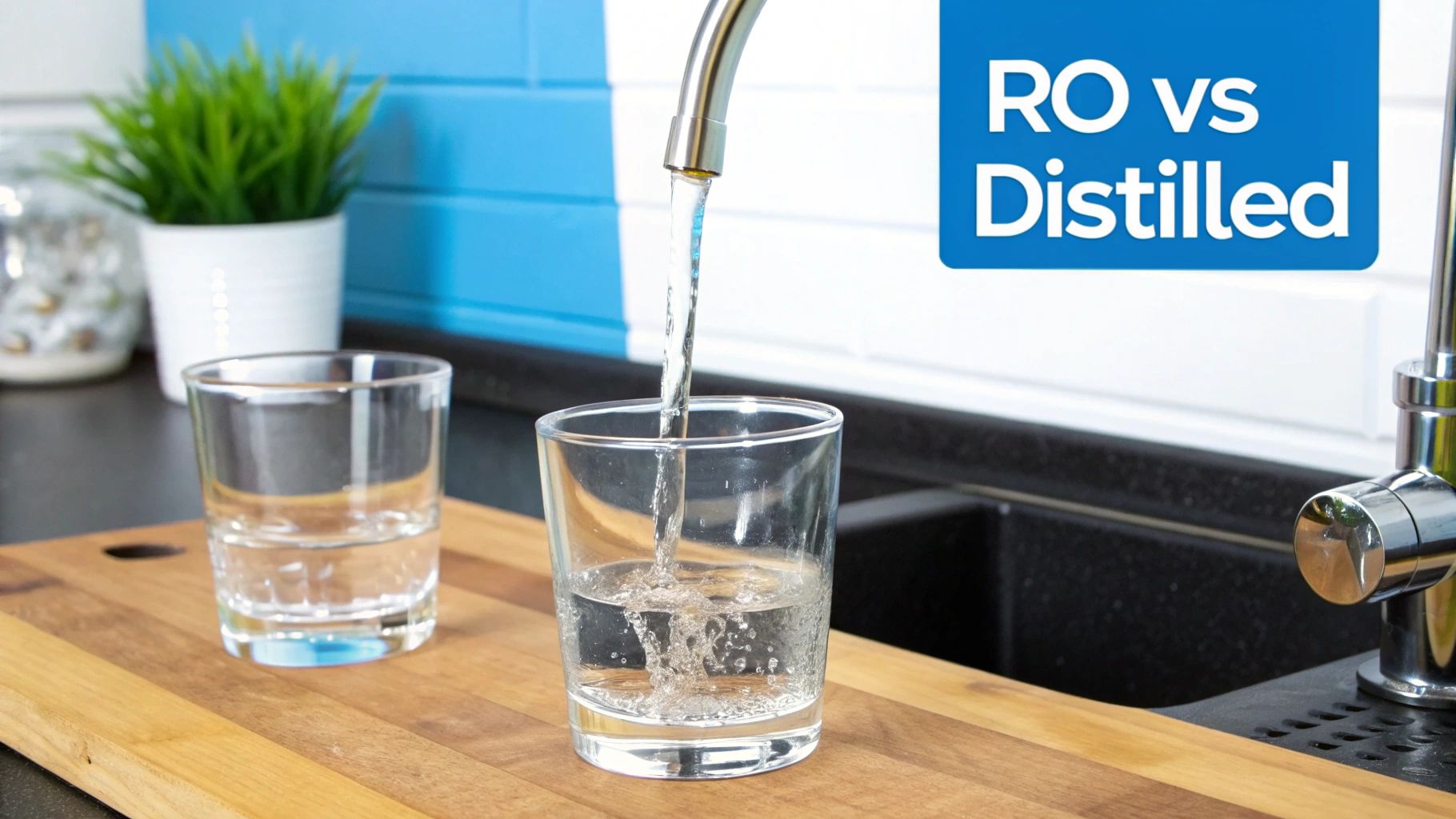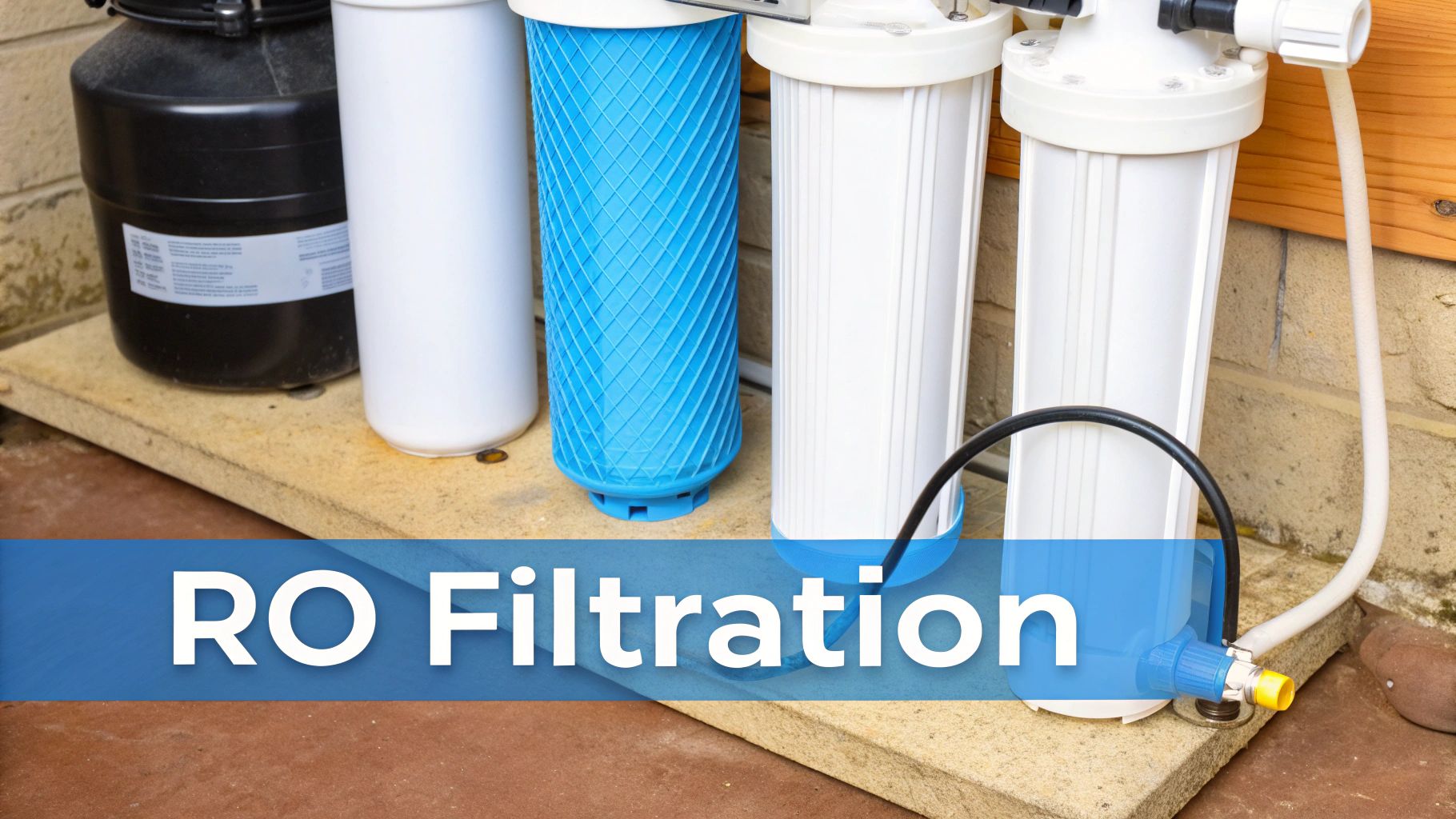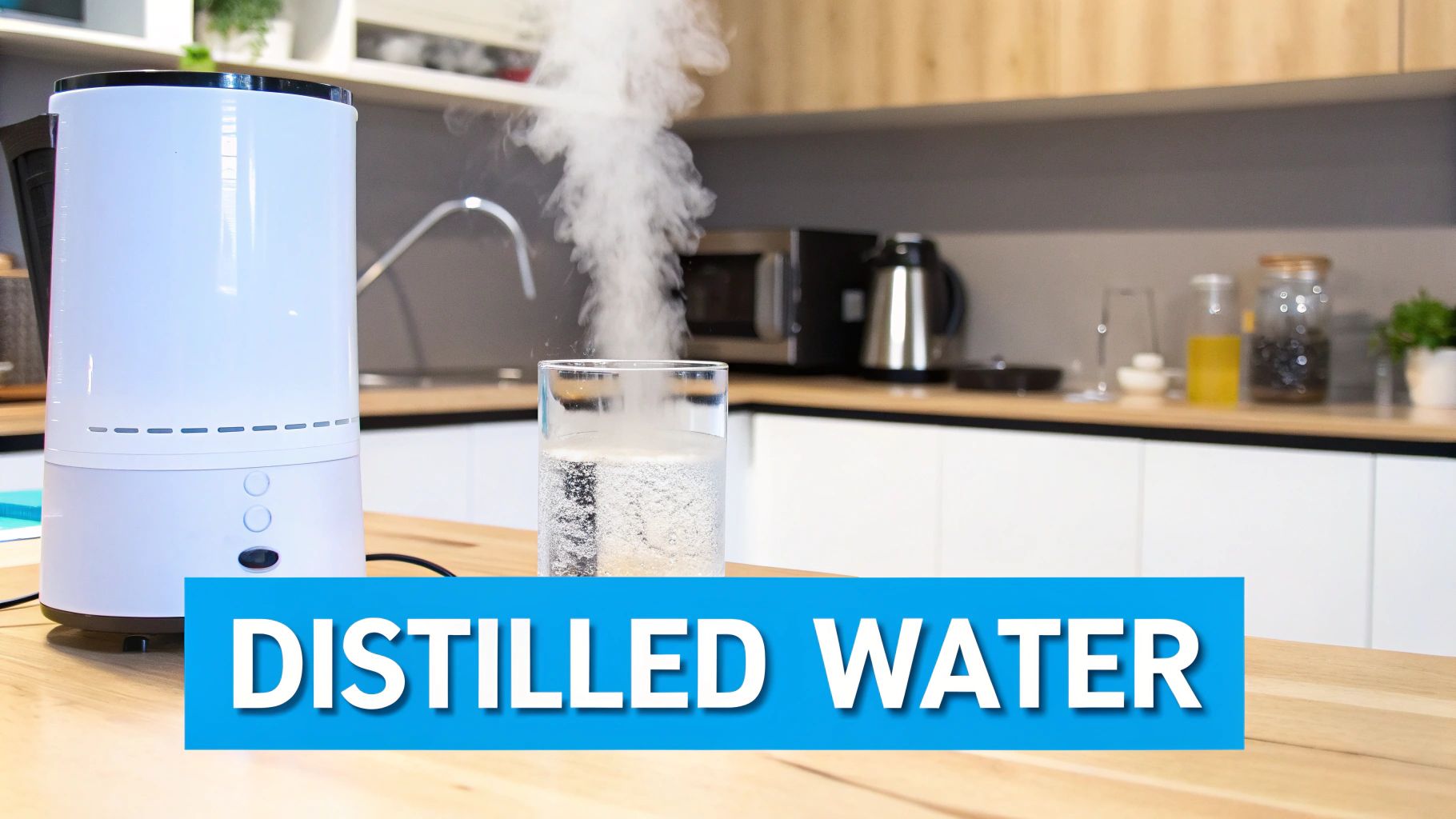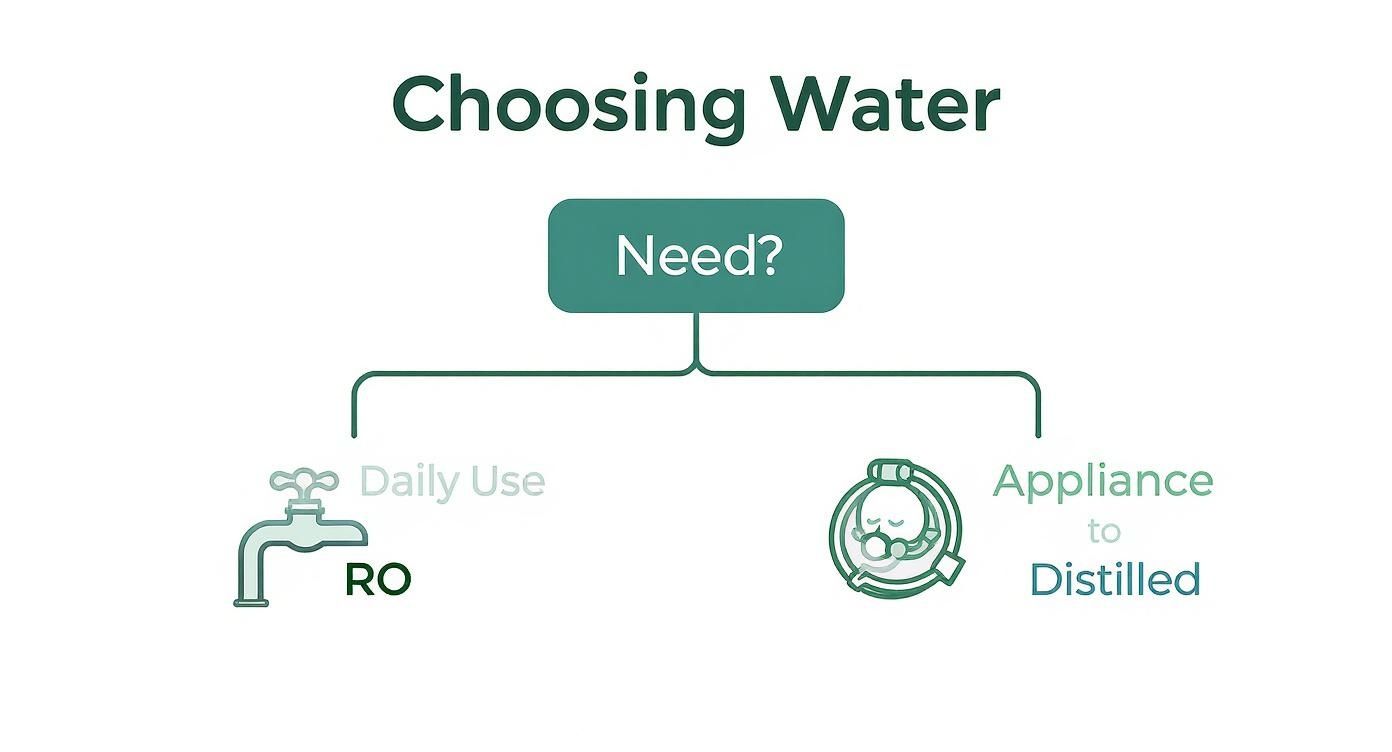
Ever stood in the water aisle, staring at bottles labeled "Reverse Osmosis" and "Distilled," and wondered what the big deal is? The real difference between RO water and distilled water isn't just marketing—it's a tale of two completely different journeys to purity, right in your own home. Think of Reverse Osmosis as a high-tech bouncer for your pipes, and distillation as a patient scientist mimicking a rainstorm on your countertop.
This one difference in how they're made changes everything, from taste and convenience to which one is the undisputed champion for your morning coffee versus your CPAP machine. Let’s dive in and find the perfect pure water for your family.
RO vs. Distilled Water: The Quick Showdown

When you want seriously clean water, it’s easy to lump "RO" and "distilled" together. They both deliver incredibly pure H₂O, but their methods are worlds apart. Understanding this is the key to choosing the right system for your home.
A Reverse Osmosis (RO) system is a filtration powerhouse that works under your sink. It uses your home's water pressure to force tap water through a mind-bogglingly fine membrane. This membrane is like a microscopic bouncer, kicking out up to 99.9% of unwanted guests like lead, chlorine, fluoride, and salts.
Distillation, on the other hand, is a purist's game. It boils water into steam, leaving virtually all contaminants behind in the boiling chamber. That pure steam is then captured, cooled, and condensed back into liquid water—nature’s rain cycle, but in a kitchen appliance. For a deeper dive into the mechanics, you can get more info on these water purification processes.
The "how" directly impacts your daily life. An RO system hooks into your plumbing, giving you a continuous stream of filtered water from a dedicated faucet. It's ready whenever you are. Distillation is a batch process; it's slow, creating a limited amount of water at a time.
Key Takeaway: The biggest difference you'll feel every day is convenience. RO offers purified water on demand for all your kitchen tasks, while distillation creates smaller batches of ultra-pure water that’s often better for specific, non-drinking uses.
Quick Look: RO vs Distilled Water
To make the choice a little easier, I've put together a quick-glance table. It breaks down the most important differences you'll notice when weighing these two water purification heavyweights for your home.
| Feature | Reverse Osmosis (RO) Water | Distilled Water |
|---|---|---|
| Purification Method | Pushes water through a fine membrane under pressure | Boils water and condenses the resulting steam |
| Production Speed | On-demand, continuous flow from a tap | Slow, batch-based (takes hours per gallon) |
| Mineral Content | Removes most minerals; can be remineralized | Removes virtually all minerals and electrolytes |
| Convenience for Home | High – integrated into plumbing for daily use | Low – countertop units produce limited quantities |
| Energy Usage | Low – uses water pressure, minimal electricity | High – requires significant electricity to boil water |
Ultimately, both methods deliver exceptionally pure water, but their day-to-day feel is worlds apart. RO is built for seamless home integration, while distillation is a more deliberate, energy-intensive process for specific needs.
How Reverse Osmosis Works in Your Home

Imagine your home's plumbing has a VIP section for water—that's basically what a Reverse Osmosis (RO) system is. It’s a sophisticated, multi-stage filtration process that uses your home's water pressure to force tap water through a series of specialized filters, producing exceptionally pure water from its own dedicated faucet.
An RO system is much more than a simple filter you'd screw onto your tap. It’s a complete purification journey. Each stage in the process has a specific job, and they all work together to strip out an incredible range of contaminants before the water ever gets to your glass.
The Multi-Stage Filtration Journey
The real magic of RO happens across several distinct steps. Most quality systems follow a similar path, even if the exact components vary a bit.
- Step 1: Sediment Pre-Filter: This is the first line of defense. Its job is to catch all the bigger stuff—rust, dirt, sand, and silt. You can think of it as clearing the way so the more delicate filters down the line can do their jobs without getting clogged.
- Step 2: Carbon Pre-Filter: Next up, the water hits an activated carbon filter (sometimes more than one). This stage is all about taste and odor, adsorbing chlorine and chloramines that your city uses for disinfection. It also tackles a variety of volatile organic compounds (VOCs).
- Step 3: The RO Membrane: This is the heart of the whole operation. Water is pushed through a semipermeable membrane with pores so tiny—around 0.0001 microns—that only water molecules can squeeze through.
This is where the heavy lifting happens. The membrane rejects a huge list of dissolved solids, including lead, arsenic, fluoride, nitrates, and salts. Getting one of these systems installed means you’ll need to understand how it connects to your pipes. It's always a good idea to brush up on the key plumbing considerations for home water systems before you start.
The Power of Pressure: The "reverse" in reverse osmosis is the whole point. In nature, water moves from a less concentrated solution to a more concentrated one. An RO system uses pressure to reverse that flow, pushing pure water molecules through the membrane while leaving the contaminants behind.
The Final Touches Before the Tap
Once purified, the water is stored in a small holding tank under your sink, so you always have a ready supply.
When you open the RO faucet, the water makes one last trip. It passes through a final carbon "post-filter" that acts as a finishing polish, removing any slight tastes or odors it might have picked up in the tank. What you get is incredibly clean, crisp water that’s perfect for drinking, cooking, or making perfectly clear ice cubes.
The Science Behind Creating Distilled Water

If Reverse Osmosis is about high-tech pressure and membranes, distillation is about getting back to basics. Think of it as mimicking nature's own purification system—evaporation and rain—right on your kitchen counter. This process doesn't just filter water; it hits the reset button.
It all starts with heating tap water in a boiling chamber. Once it hits its boiling point, the water turns into steam, and this is where the magic happens. As the H₂O molecules turn into a gas, they leave almost everything else behind.
Heavy metals like lead, minerals such as calcium, bacteria, viruses, and a whole host of other contaminants just can't make the leap from liquid to vapor. They’re left behind as sediment in the boiling chamber.
Capturing Pure Steam
After creating pure water vapor, the next step is to turn it back into liquid. The steam rises out of the boiling chamber and gets funneled into a cooling coil or corridor. A fan or other cooling mechanism then drops the temperature.
This rapid cooling forces the steam to condense back into liquid water. What you get is exceptionally pure, stripped of the overwhelming majority of contaminants that were in your tap water to begin with.
Key Insight: This is the absolute core difference between RO and distilled water. Distillation physically separates pure H₂O from its baggage by changing its state from liquid to gas and back again. It’s one of the most thorough purification methods out there.
The Batch-Based Nature of Distillation
Unlike the constant flow you get from an RO system, distillation is a batch-based process. Most countertop distillers produce water one gallon at a time, and it's not a quick affair.
- Time Commitment: It can take anywhere from 3 to 5 hours just to produce a single gallon of distilled water. This makes it a non-starter if you need to fill a big pot for pasta or quickly rinse some veggies.
- Energy Consumption: Keeping water at a rolling boil for hours chews through a fair bit of electricity. This is a real operational cost to weigh against the more energy-efficient, pressure-driven RO systems.
Because it’s so slow and uses more power, distilled water at home is usually reserved for special uses where absolute purity is critical. It's fantastic for things like CPAP machines or steam irons, where mineral buildup can wreak havoc. While you can certainly drink it, the production method just isn't as convenient as RO for everyday hydration.
What Gets Pulled Out? A Head-to-Head on Contaminant Removal
When you're picking a water filtration system for your home, the bottom line is simple: what does it actually take out of my water? This is where the real difference between RO water and distilled water becomes crystal clear. It's time to see how they stack up against specific contaminants.
Reverse Osmosis systems are the special forces of water filtration. Their semipermeable membrane is engineered to target and eliminate dissolved solids, making it a champion for tackling common tap water problems with precision.
Distillation, on the other hand, is less targeted and more of a total reset. By boiling water into steam and leaving everything else behind, it produces one of the purest forms of H₂O possible in a home setting. This includes beneficial minerals, which are left behind with the bad stuff.
Where Reverse Osmosis Shines
If you're worried about the invisible junk lurking in your municipal water supply, an RO system is a fantastic choice. It's especially good at knocking out specific inorganic contaminants that most basic filters just can't touch.
You can count on a solid RO membrane to remove:
- Heavy Metals: Lead, arsenic, mercury, and chromium don't stand a chance.
- Dissolved Salts: This includes sodium. It’s the same technology used to make ocean water drinkable.
- Fluoride: RO is one of the most reliable ways to remove fluoride from your drinking water.
- Nitrates and Sulfates: These common contaminants from agricultural runoff are rejected by the membrane.
Basically, if it's a dissolved inorganic solid, a good RO system is going to pull it out. This makes it an incredibly practical solution for making your daily drinking water safer and taste better.
The Gist: Reverse Osmosis is a master at removing dissolved minerals, salts, and heavy metals. It’s a targeted approach that seriously purifies tap water without the hassle, making it perfect for everyday household use.
The Tricky Case of VOCs
Now, things get a little more interesting when we talk about Volatile Organic Compounds (VOCs). These are chemicals like pesticides and solvents that can turn into a gas easily, and this is where the two methods really part ways. While both are great at removing most contaminants, they handle this group differently. For a deeper dive, you can explore RO and distilled water differences on shellwatersystems.com to get more insights into this key distinction.
This is exactly why you'll see high-quality RO systems with more than just a membrane. They almost always include activated carbon filters both before and after the RO stage. These carbon filters are designed specifically to grab onto VOCs, covering the one real blind spot the RO membrane has.
With distillation, you can run into a snag with VOCs that have a lower boiling point than water. When you heat the water, these chemicals can vaporize right along with it, travel over to the cooling coils, and condense straight back into your "pure" water. The better distillers solve this by adding a carbon filter to catch these pesky compounds, but it's a critical point to remember when you're weighing your options.
Taste, Minerals, and What It Means for Your Health
So, does purified water actually taste different? You bet it does. When you strip almost everything out of water—which both Reverse Osmosis and distillation do—you completely change its taste profile. It's often the first thing people notice.
The taste you're used to from tap water comes from dissolved minerals like calcium and magnesium. Since both RO and distillation remove these, the water can taste "flat" or even "empty." It’s not a bad thing, just different from the mineral-rich water our taste buds expect.
Do We Need Minerals in Our Water?
This is a big question for a lot of homeowners: is it unhealthy to drink water without minerals? While our bodies definitely need minerals like calcium and magnesium to function, the truth is we get the overwhelming majority of them from our food, not our water.
A balanced diet full of fruits, veggies, and other whole foods provides far more minerals than you’d ever get from drinking water. For most healthy people, the benefit of removing potentially harmful contaminants far outweighs the removal of a few trace minerals.
The Real Story on Taste and Health: The "flat" taste of pure water is simply a lack of the minerals we're used to. It's a taste issue, not a health one. A good diet will give you all the essential minerals you need, making the purity of RO or distilled water a clear win.
Remineralization: The Big Advantage of RO
Here’s where Reverse Osmosis systems really pull ahead, especially if you want pure water that also tastes great. This is a crucial difference between RO water and distilled water if you plan on drinking it every day.
Many modern RO systems come with an optional remineralization filter. This is the last stage before the water comes out of your faucet, and it adds a balanced blend of healthy minerals like calcium and magnesium back into the water. This does two great things:
- Brings the Taste Back: It gets rid of that "flat" taste and gives the water a crisp, refreshing flavor.
- Balances the pH: Adding minerals back in raises the water's pH, making it less acidic and more alkaline.
This feature makes RO systems incredibly versatile. You get the security of knowing your water is incredibly pure, but you can also tailor the final product to have the taste and mineral content your family prefers.
A Practical Breakdown of Cost and Maintenance
When you're looking at getting a water filtration system for your home, the sticker price is just the beginning. The real cost shows up over time, once you factor in the day-to-day expenses and upkeep. Let's get practical and break down the financial difference between RO water and distilled water so you know what you're really signing up for with your budget and your time.
An under-sink RO system is definitely more of an upfront investment, but it’s built to be a seamless part of your kitchen for the long haul. A countertop distiller, on the other hand, is usually cheaper to buy, but it has its own running costs to think about. It really comes down to whether you'd rather spend more now for convenience later, or save on the initial purchase and pay as you go.
Comparing Long-Term Financials
A modern RO system will typically set you back somewhere between $550 and $1,000 to get it installed. In contrast, you can pick up a countertop distiller for $200 to $650. But that’s where the savings can stop. Distillers are slow, often taking 5-6 hours to produce a single gallon of water, and all that boiling uses a noticeable amount of electricity. If you want a complete picture of how these costs stack up, you can discover more insights about these cost differences on shellwatersystems.com.
RO systems have their own recurring expenses, mainly the yearly filter changes. You can expect to spend about $50 to $150 per year on new filters, depending on your system and local water quality. For most households, this predictable annual cost ends up being less than the extra electricity you’d pay for by running a distiller regularly.
The Bottom Line on Budget: An RO system costs more upfront but has lower, more predictable running costs. A distiller is cheaper to buy but can lead to a surprisingly high electricity bill, especially if you use it a lot.
Understanding Maintenance Routines
The time you'll spend on upkeep is another big difference between these two systems. Both need some simple, regular attention to keep them running well and hygienically, but the tasks are quite different.
-
RO System Maintenance: This is mostly a "set it and forget it" situation. You'll swap out the pre-filters and post-filter once a year. The main RO membrane is much more durable, usually lasting 2-4 years. Every year or two, you should also sanitize the storage tank to keep any potential bacteria from growing.
-
Distiller Maintenance: Because a distiller works by boiling water and leaving all the gunk behind, that gunk has to be cleaned out. You’ll need to descale the boiling chamber frequently—sometimes as often as weekly—by soaking it with a vinegar solution to dissolve all that mineral buildup. If you don't, it won't run efficiently and could eventually get damaged.
Choosing the Right Water for Your Home
So, what's the verdict? The best water filtration system is always the one that fits your life, not the other way around. After digging into the processes, costs, and the final product, your choice really boils down to what your household actually needs.
The core difference between ro water and distilled water isn't about which one is "better" overall, but what you plan to do with it. One is built for everyday life, the other for very specific, purity-critical tasks.
Think of it this way: if your main goal is to have a steady, on-demand supply of fantastic-tasting, clean water for drinking, cooking, and making ice, a Reverse Osmosis system is going to be your best bet, hands down. It hooks right into your plumbing and can even add healthy minerals back in, making it a practical, set-it-and-forget-it upgrade for your home's water.
Scenario-Based Decision Making
But what if your needs are more specific? That's where distilled water shines. For things like medical equipment (think CPAP machines) or small appliances like steam irons and humidifiers, mineral buildup can be a death sentence. In these cases, the absolute, uncompromising purity of distilled water is exactly what you need.
This visual guide breaks it down perfectly.

As you can see, the right choice becomes obvious once you pinpoint the primary use—are you drinking it or are you protecting an appliance?
And speaking of appliances, water quality can make or break them. For instance, good considerations for selecting a coffee machine always touch on how water purity impacts taste and the machine's lifespan.
Final Takeaway: Go with an RO system for convenient, great-tasting water for all your kitchen needs. Choose distilled water when you need 100% mineral-free water for specific appliances or medical devices to stop mineral scale in its tracks.
By matching the water type to your family's habits and unique needs, you can make the right call with confidence. If you're still on the fence, you can always explore more water filter advice to find the perfect fit.
At Water Filter Advisor, our goal is to help you make a smart, informed decision. Check out our in-depth guides and reviews to find the ideal filtration system for your family at https://www.waterfilteradvisor.com.
- November 7, 2025
- 0
- Uncategorized
